
Kogarkoite is a sodium sulfate fluoride mineral with formula Na3(SO4)F. It has a pale blue color, a specific gravity of about 2.67 and a hardness of 3.5. The crystal is monoclinic and is a type of naturally occurring antiperovskite. Kogarkoite is named after the Russian petrologist Lia Nikolaevna Kogarko (born 1936) who discovered the mineral.

Cassiterite is a tin oxide mineral, SnO2. It is generally opaque, but it is translucent in thin crystals. Its luster and multiple crystal faces produce a desirable gem. Cassiterite was the chief tin ore throughout ancient history and remains the most important source of tin today.
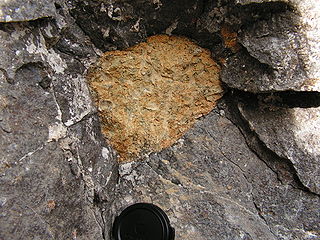
Nephelinite is a fine-grained or aphanitic igneous rock made up almost entirely of nepheline and clinopyroxene. If olivine is present, the rock may be classified as an olivine nephelinite. Nephelinite is dark in color and may resemble basalt in hand specimen. However, basalt consists mostly of clinopyroxene (augite) and calcic plagioclase.
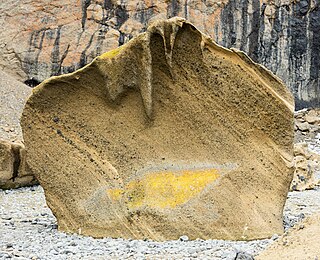
Tephra is fragmental material produced by a volcanic eruption regardless of composition, fragment size, or emplacement mechanism.

Cotunnite is the natural mineral form of lead(II) chloride (PbCl2). Unlike the pure compound, which is white, cotunnite can be white, yellow, or green. The density of mineral samples spans range 5.3–5.8 g/cm3. The hardness on the Mohs scale is 1.5–2. The crystal structure is orthorhombic dipyramidal and the point group is 2/m 2/m 2/m. Each Pb has a coordination number of 9. Cotunnite occurs near volcanoes: Vesuvius, Italy; Tarapacá, Chile; and Tolbachik, Russia.

Carbonatite is a type of intrusive or extrusive igneous rock defined by mineralogic composition consisting of greater than 50% carbonate minerals. Carbonatites may be confused with marble and may require geochemical verification.

Eudialyte, whose name derives from the Greek phrase Εὖ διάλυτος, eu dialytos, meaning "well decomposable", is a somewhat rare, nine-member-ring cyclosilicate mineral, which forms in alkaline igneous rocks, such as nepheline syenites. Its name alludes to its ready solubility in acid.
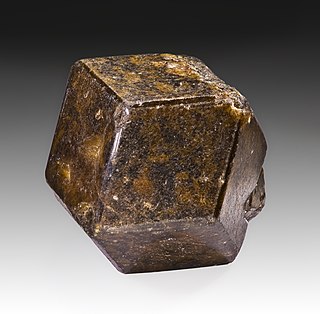
Andradite is a mineral species of the garnet group. It is a nesosilicate, with formula Ca3Fe2Si3O12.
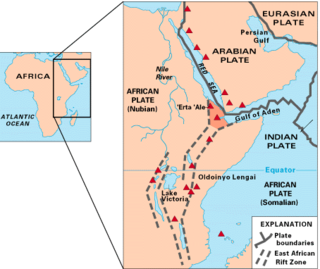
The East African Rift (EAR) or East African Rift System (EARS) is an active continental rift zone in East Africa. The EAR began developing around the onset of the Miocene, 22–25 million years ago. It was formerly considered to be part of a larger Great Rift Valley that extended north to Asia Minor.

Natrocarbonatite is a rare carbonatite lava which erupts from the Ol Doinyo Lengai volcano in Tanzania within the East African Rift of eastern Africa. Natrocarbonatite lavas were first documented in 1962, by J. B. Dawson.

Aenigmatite, also known as cossyrite after Cossyra, the ancient name of Pantelleria, is a sodium, iron, titanium inosilicate mineral. The chemical formula is Na2Fe2+5TiSi6O20 and its structure consists of single tetrahedral chains with a repeat unit of four and complex side branches. It forms brown to black triclinic lamellar crystals. It has Mohs hardness of 5.5 to 6 and specific gravity of 3.74 to 3.85. Aenigmatite forms a solid-solution series with wilkinsonite, Na2Fe2+4Fe3+2Si6O20.
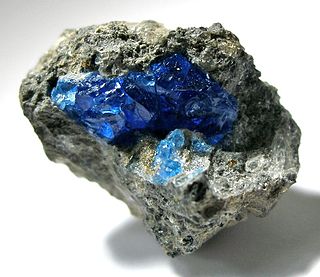
Hauyne or haüyne, also called hauynite or haüynite, is a Rare tectosilicate sulfate mineral with endmember formula Na3Ca(Si3Al3)O12(SO4). As much as 5 wt % K2O may be present, and also H2O and Cl. It is a feldspathoid and a member of the sodalite group. Hauyne was first described in 1807 from samples discovered in Vesuvian lavas in Monte Somma, Italy, and was named in 1807 by Brunn-Neergard for the French crystallographer René Just Haüy (1743–1822). It is sometimes used as a gemstone.

Nyerereite is a very rare sodium calcium carbonate mineral with formula Na2Ca(CO3)2. It forms colorless, platey pseudohexagonal orthorhombic crystals that are typically twinned. It has a specific gravity of 2.54 and indices of refraction of nα=1.511, nβ=1.533 and nγ=1.535. Nyerereite is not stable in contact with the atmosphere and rapidly breaks down. Collection specimens must be kept in a sealed argon environment.
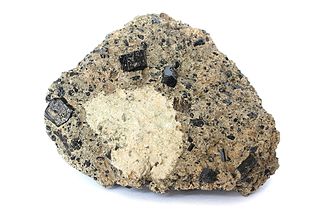
Kaersutite is a dark brown to black double chain calcic titanium bearing amphibole mineral with formula: NaCa2(Mg3Ti4+Al)(Si6Al2)O22(O)2.
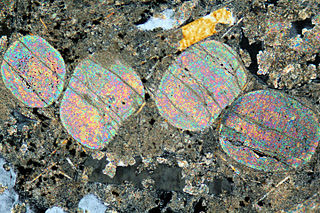
Gregoryite is an anhydrous carbonate mineral that is rich in potassium and sodium with the chemical formula (Na2,K2,Ca)CO3. It is one of the two main ingredients of natrocarbonatite, found naturally in the lava of Ol Doinyo Lengai volcano of Arusha Region, Tanzania, and the other being nyerereite.
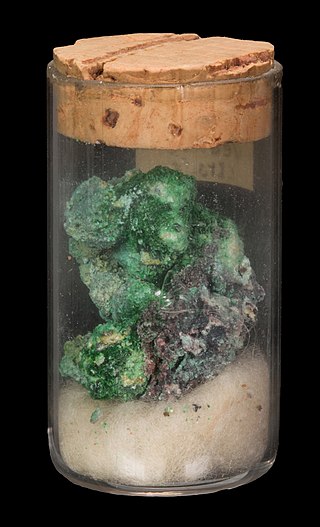
Euchlorine (KNaCu3(SO4)3O) is a rare emerald-green sulfate mineral found naturally occurring as a sublimate in fumaroles around volcanic eruptions. It was first discovered in fumaroles of the 1868 eruption at Mount Vesuvius in Campania, Italy by Arcangelo Scacchi. The name 'euchlorine' comes from the Greek word εΰχλωρος meaning "pale green" in reference to the mineral's color, other reported spellings include euclorina, euchlorin, and euchlorite.
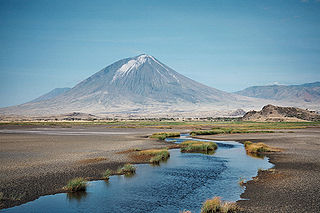
Ol Doinyo Lengai is an active volcano in northern Tanzania. It consists of a volcanic cone with two craters, the northern of which has erupted during historical time. Uniquely for volcanoes on Earth, it has erupted natrocarbonatite, an unusually low temperature and highly fluid type of magma. Eruptions in 2007–2008 affected the surrounding region.

The Empakaai Crater or Embagai is a collapsed volcanic caldera that is 300 meters high and 6 kilometers wide located in Naiyobi ward of Ngorongoro District in Arusha Region of Tanzania. The Crater is filled by a deep alkaline lake that occupies around 75% of the Crater's bottom and is approximately 85 meters deep. The crater is a caldera and is within UNESCO Biosphere Reserve protection program Empakaai's elevation on the outside is 3,200m above sea level on the western side and 2,590m above sea level on the eastern side. Empakaai is nearly always blanketed in mist due to its high altitude, and the lake appears emerald or deep blue in color. The crater is part of the Crater Highlands geographic zone.

Kerimasi Volcano, also known as Kerimasi at 2,602 metres (8,537 ft) is an extinct shield volcano located in Monduli District of Arusha Region in Tanzania. The majority of the mountain lies in Engaruka Ward, and a quarter of it is in the Ngorongoro Conservation Area. The volcano is located in the geographic area known as the Crater Highlands and is a shield volcano that last erupted in the Pleistocene.

Saidman volcano, also known as Sadiman or Satiman, is 2,879-meter-high stratovolcano located in Ngorongoro District of Arusha Region in Tanzania. The volcano is located in the geographic area known as the Crater Highlands and is a volcano that last erupted in the Pleistocene. The age of Sadiman volcano is unknown, with one source claiming a Pleistocene age and another claiming a K-Ar age of 4.5 million. Sadiman lava clasts have been discovered in layers dating back 1.7 to 2.0 million years. This volcano is part of the Serengeti-Ngorongoro UNESCO Biosphere Reserve in partnership with the Ngorongoro Conservation Area.




















